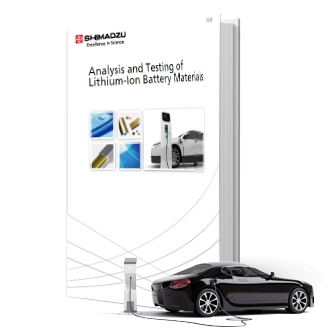Lithium-Ion Batteries
Due to its high energy density, Li-ion batteries are widely considered as a favorable energy storage technology and are gaining immense popularity in EV. Systematic evaluation of the individual components within Li-ion batteries is critical for better EV performance. Here, we present the most optimal solutions to uncover valuable insights for higher efficiency, long-lasting durability, and maximum safety of Li-ion batteries.

Download the Guide for Complete Solution to Li-Ion Batteries Analysis!
Investigating the Electrodes
During the discharge, Li ions travel from the anode to the cathode, causing electrons to move externally which generates a current flow to power the device. In the charging process, the Li ions travel in the opposite direction. Currently, research on electrodes in Li-ion batteries focuses on different materials to increase its energy density and improve material stability for higher tolerance of charge voltages to ensure safety. Our comprehensive range of instruments can offer the right tools for detailed evaluation of specific components in the electrodes.

Active Material
Composition (ICPES, ICPMS, EPMA, XRF)
Crystallinity (XRD)
Particle Size (Particle Size Analyzer)
Electron State (EPMA, XPS)
Conductivity (SPM)
Distribution (EPMA)
Binder
Molecular Weight Distribution (GPC)
Composition (FTIR)
Conductivity (SPM)
Distribution (EPMA)
Conduction Enhancer
Crystallinity (XRD)
Conductivity (SPM)
Distribution (EPMA)
Optimizing the Electrolyte Solution
The electrolyte solution contains organic solvent, salts, and additives. It acts as a medium for Li ions to move between the electrodes during the charge/discharge process. Ideally, the electrolyte should be inert and possess superior ionic conductivity to facilitate the transport of Li ions. To combat unwanted self-discharge and electrolyte degradation, it is favorable for the electrolyte solution to have low electronic conductivity and a wide electrochemical window. Other desirable characteristics include low toxicity and high thermal stability. Click below to find out suitable instruments for the analysis of organic solvents, electrolyte salts, and their additives.
Characterizing Separator Materials
Separator is yet another crucial component in Li-ion batteries which mechanically separates the electrodes within the system. It is often thin and porous, commonly made up of polymer materials such as polyethylene and polypropylene. The separator plays a decisive role in affecting the battery’s cell performance, life span, and most importantly safety. Therefore, research is usually critically focused to study some of its properties, such as elasticity, thermal stability, and its deterioration behavior using a range of analytical instruments, such as FTIR and TGA.
Material Testing of Cells & Modules
Multiple Li-ion battery cells can be gathered and installed together as a module. Regardless of which form it takes, it is important to conduct material testing for Li-ion batteries to ensure top quality and utmost safety for the benefit of the consumers. Typical material studies include fatigue testing, mechanical strength testing, and using an X-ray imaging system to obtain accurate internal observations of the battery for any structural defects. With our latest technology, Shimadzu offers the highest class of testing machine AGX-V, a highly sensitive X-ray CT system, and many more instruments for superior performance in material testing.

